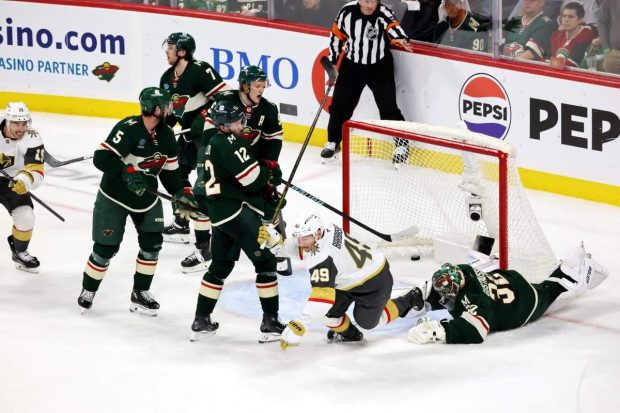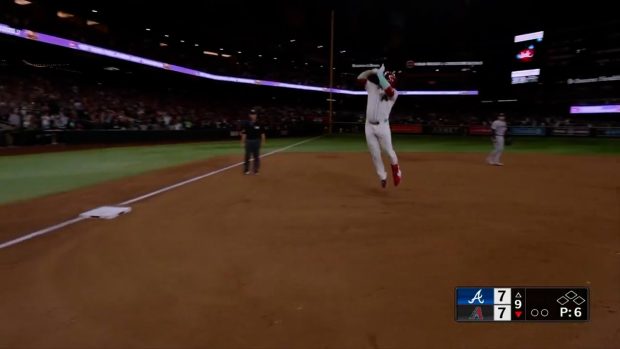

It’s only two games into the New York Knicks’ and Detroit Pistons’ first-round playoff series and pandemonium has already unfolded.
For New York, its 40-point fourth quarter in Game 1 — spearheaded by a 21-0 run to pull off the comeback win — was just the second time in franchise history that the Knicks scored 40 points or more in one period of a playoff game, with the last time coming in 1955. For Detroit, a Game 2 win marked the franchise’s first playoff victory in 17 years. Pistons star Cade Cunningham was just 6 years old when the team last won a postseason game in 2008.
Advertisement
What will happen next?
To break down the series so far and look ahead with Game 3 coming up, The Athletic’s Knicks beat writer James L. Edwards III and senior NBA writer Fred Katz discussed one of the playoffs’ most interesting series.
How would you describe this series so far?
Edwards: A puzzle, like most playoff series are.
Game 1 was the first time this current iteration of the Pistons had tasted the postseason, and I thought the veteran-led Knicks did a good job of taking advantage of that. Detroit couldn’t figure out how to get OG Anunoby off of Cunningham. The Knicks’ stopper was everywhere that the Pistons star guard went. Anunoby forced him to go left. Karl-Anthony Towns was tremendous with his blitzing and active hands in the pick-and-roll. It led to Cunningham having a subdued playoff debut.
Then fast-forward to Game 2, and the Pistons countered what the Knicks did in Game 1 by attacking Jalen Brunson early and often by screening Anunoby with whomever was guarding Brunson, as well as putting Anunoby in a ton of screens early into a possession. Detroit was also better at the act of setting screens in the game.
On the other side, the Knicks and Brunson were clearly flustered by the Pistons’ physicality and defense in their Game 2 loss. That led to some ugly offense and flared tempers. New York has also struggled to get Towns clean looks from 3, whether that’s due to ballhandlers or the need for more play calling as opposed to random offense.
How New York combats those two things in Game 3 — or maybe doesn’t — is the next puzzle piece I’m looking forward to seeing.
Katz: I can use only a made-up adjective to describe Knicks-Pistons: Bad Boy-ish.
Greater than the effect of the Pistons’ defense is their identity. Each member of the team conducts himself the same way — as if it’s 1990.
Advertisement
Tobias Harris is winning a game of physicality against Towns. Jalen Duren is soaring for rebounds. Ausar Thompson is pressing Brunson full court. If he slaps his forearm 80 feet from the paint, so be it. The Knicks didn’t receive borderline calls during the first half of Game 2, not drawing their first shooting foul until the third quarter against a squad that usually hacks anyone who moves.
If the Pistons can play how they want, turning games into rock fights, they give themselves a chance. And through a couple of games, the Knicks have played into that hand.
They aren’t getting into their sets quickly, which is bogging down the offense. Brunson has leaned into too much one-on-one ball, especially during Game 2, when he hunted fouls down the stretch.
The first two bouts have looked more like Pistons games than Knicks ones.
What has surprised you most from a Knicks perspective?
Edwards: I could go a couple of ways here — like Towns only having five 3-point attempts through two games or Detroit being the more consistent team quarter-to-quarter so far in this series — but I’m going to go with this: When Cunningham isn’t on the court, if my math is correct, the Knicks are a minus-5. That can’t happen.
Cunningham has sat for a total of 15 minutes through the two games and Detroit has never once had to pay for it by the time he checks back in.
The Knicks were favorites in this series in large part due to their experience and talent but also because the Pistons are without a true No. 2 playmaker behind Cunningham. Yet, defense travels and enough of Detroit’s role players have hit shots when Cunningham is on the bench.
Katz: For all the hand-wringing about necessary changes for Game 3, about Towns not receiving a shot in the fourth quarter or Mikal Bridges missing a jumper that would have tied it down the stretch, the basic adjustment is staring the Knicks straight in the face: Play better.
Advertisement
Not one Knicks player has played consistently well for both of the playoff games.
Brunson missed shots at the beginning of Game 1 and went 1 of 5 during crunchtime of Game 2. Anunoby pestered Cunningham one night until Cunningham reciprocated a couple of days later. Towns has gone missing. Josh Hart got into foul trouble in Game 1. Hart’s presence, meanwhile, allows the Pistons to guard Towns with a wing, a reason for Hart’s struggles. Miles McBride was scoreless in Game 1. Cameron Payne picked up three fouls in a minute in Game 2 after his fire-breathing Game 1. Bridges didn’t even get to close Game 1. Mitchell Robinson is a beast on the boards but the floor shrinks when he’s out there.
Chances are, these trends won’t all continue.
If Brunson has a normal Brunson performance in Game 2, the Knicks probably win that game. If Towns plays like 80 percent of himself, same.
This game can go two ways. The Pistons missed 3-pointers galore Monday and still squeaked out a win. Had they hit their jumpers, it could have been a blowout. But the Knicks don’t look like themselves. And while it’s possible they never do in this series, the more likely scenario is at least a couple of these guys start playing like they did over the first 82 games.
Jalen Brunson through 2 Playoff Games:
35.5 PTS (44.4% FG)
2.5 REB
7.5 AST
35.3% 3PContinues to show that he’s made for this. pic.twitter.com/KvO019pTd3
— KnicksMuse (@KnicksMuse) April 22, 2025
What is one adjustment the Knicks can make heading into Game 3?
Edwards: For me, it’s two-lineup adjustments.
Detroit outrebounded New York by 14 in Game 2. A heavier dose of Towns-Robinson frontcourt minutes might help in that department, especially with the possibility of the Pistons’ Isaiah Stewart being out due to injury.
The other, and Fred dove into this yesterday, is more McBride with the starters. New York should invest more time into a true five-out lineup given how much more success opposing teams have against the Knicks when they’re able to defend Towns with a wing or guard as opposed to the lack of success they have when Towns is guarded by a center.
Advertisement
Katz: Brunson did not act like himself in Game 2 — and it wasn’t just during the fourth quarter.
The Knicks’ captain may be a score-first point guard, but his floor game has improved drastically over the past three seasons. For some reason, Brunson reverted Monday night, calling his own number when doing so wasn’t the best basketball play.
Watch this second-quarter possession, where Brunson takes off against Pistons guard Dennis Schröder. Head coach Tom Thibodeau constantly reminds his team that the best way to create 3-pointers in the half court is by getting into the paint and, as he puts it, “spraying” the ball back out to the perimeter.
Brunson does the first part of that well. As he heads right, Pistons center Paul Reed leaves Towns to help his teammate. The Knicks have drawn two defenders to the ball with their best shooter wide open at the top of the arc.
But instead of the play ending in a Towns 3-pointer, Brunson clanks a fadeaway as Towns claps for a pass:
It reminds me of another classic Thibodeau phrase, which he often repeats: “The game tells you what to do.”
The game told Brunson what to do throughout the Knicks’ most recent loss. But Brunson didn’t always react properly. Normally, he does. And if he returns to his normal self, which is to be expected, New York will be in a better place.
What’s the concern level if you’re the Knicks after two games?
Edwards: I think New York’s concern level should be at about seven. Maybe 7.5. The Knicks, despite all of their key players having playoff experience, have looked like the more rattled team so far. Detroit’s physicality and defense has continuously poked at New York throughout this series. The Knicks, mainly Brunson, need to adjust to how the game is being called in the postseason rather quickly.
Also, New York just isn’t a good 3-point shooting team right now and hasn’t been for a while, and I’d worry about that against a team like Detroit. From Jan. 1 until the end of the regular season, the Knicks not only ranked 29th in 3-point attempts per game (32.7), per NBA.com, but also 20th in efficiency (35.5).
Advertisement
In Game 2, New York was 1 for 10 on wide-open 3s, per NBA.com. However, the Pistons may be without Stewart, and while Duren stepped up tremendously on defense in Game 2, can he do so consistently? Can the likes of Harris, Dennis Schröder and Tim Hardaway Jr. break their labels of being streaky 3-point shooters for the remainder of this series? All three still have to prove it.
New York’s talent hasn’t really overwhelmed Detroit yet. The Knicks need to find a way to utilize all of their weapons better going forward.
Katz: I won’t overreact to a split at home. I still think the Knicks, who have four of the five best players in this series, win it. The talent discrepancy is too vast. I’m sure they will implement some of the changes we mentioned above for Game 3 — and that they will think of some we couldn’t.
But the way New York has come out of the gate makes what already felt like an impossible task in Round 2, where the Boston Celtics would be waiting, seem even steeper.
(Photo of Jalen Brunson guarding Cade Cunningham in Game 2: Al Bello / Getty Images)
This news was originally published on this post .










Be the first to leave a comment